Scoring goals is far and away the most entertaining and loveable aspect of the beautiful game. Watching supporters leap around in boisterous chaos while the ground of the stadium rumbles beneath their feet is a truly glorious sight to behold.
However, while scoring goals is the aim of football, keeping them out of the other end is the most important element of a successful side. At the risk of sounding blunt and condescendingly obvious, if a team don’t concede goals, they cannot lose.
The prime example of this in the 2022/23 campaign has been Preston North End. Perhaps surprisingly, Ryan Lowe’s side have the best defensive record in England’s top four divisions this season so far, and have yet to concede a single goal in their five league matches.
In fact, goalkeeper Freddie Woodman just became the first ever goalkeeper for the historic club to keep five consecutive clean sheets in the league. Bear in mind that the Lilywhites were founded 142 years ago which makes this all the more impressive.
Furthermore, Preston have perhaps worryingly bagged just one goal over these five games, and while it was a ridiculously eye-watering strike, without their perfect clean sheet record, Lowe’s men could have found themselves down near the foot of the table.
This tactical analysis piece will be a scout report of Preston’s defensive tactics. It will be an analysis, looking at why the Championship side are conceding so few goals in the league and how this intertwines with the lack of goalscoring too.
Preferred formation
During his time with Plymouth Argyle, Lowe was a massive advocate for variations of a back three, interchanging between a 3-4-1-2, a 3-5-2 and even a 3-4-2-1. This suited the players available to him as the Pilgrims rose up the table and performed admirably.
While at Home Park, Preston were being managed by Frankie McAvoy who was with the club from March 2021 to December of the same year. The Scot was dismissed midway through the 2021/22 campaign due to excessively poor results and Lowe was placed in charge.
Throughout the campaign, under both McAvoy and Lowe, Preston primarily set up in the 3-4-1-2, although the Lilywhites were no stranger to its close cousins, the 3-5-2 and 3-4-3. Nevertheless, there was still some use for more conventional back four shapes.
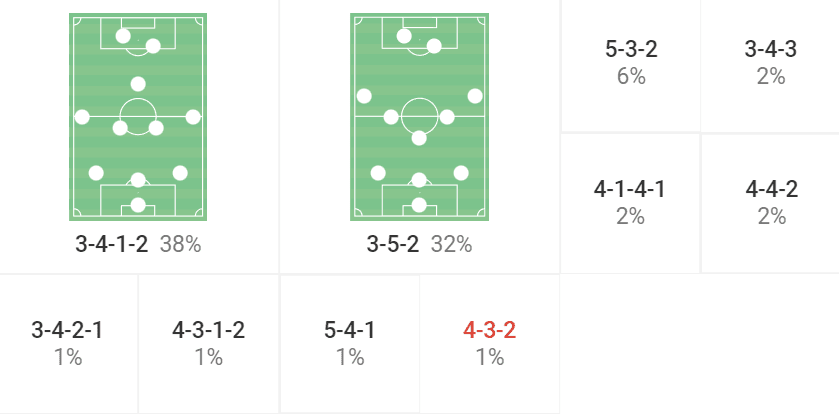
Now, with Lowe into his first full season in charge of the club, the manager has not skewed from his love of back three systems. The only time a four-man defence has been seen at Deepdale, it has been from the opposition.
This campaign, the 3-4-2-1 has been the go-to for the manager. Used by Chelsea and Tottenham Hotspur in the Premier League, it provides a wonderful balance to the side in the attacking and defensive phases.
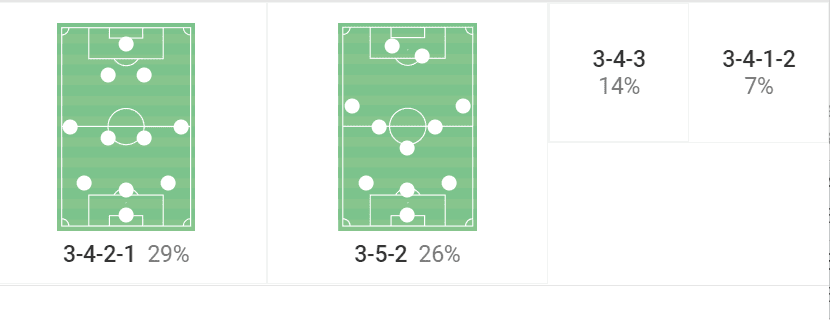
Overall, the 3-4-2-1, including the wider 3-4-3, has been deployed by Lowe in 43 percent of the team’s games in all competitions. The 3-5-2 is in second, followed by the 3-4-1-2.
Of course, out of possession, this structure reverts into either a 5-2-3 or a 5-4-1 depending on how low down the pitch the defensive block is situated.
Regardless, simply setting your team up in a certain formation will not prevent goals from going into the net. Let’s take a look at the exact reasons why Preston have been so astute and efficient in the defensive phases this season.
Pressing to dictate the opposition’s play
In football, some teams press high up the pitch into the opponent’s defensive third in order to aggressively regain possession. Sides like Liverpool and Bayern Munich are perfect examples of this. From there, these teams can cause a turnover in possession in the final third and transition rapidly to create a chance in a wonderful position.
However, this is not the only form of defending in a high block. Often, teams prefer to set themselves up in a certain structure but their objective when pressing is to force the opposition into a certain area of the pitch. Preston fall under this category.
When pressing high in Lowe’s 3-4-2-1, the players, particularly the front three, are instructed to block off access to the opposition’s single or double-pivot, while angling their pressure to force the ball carrier to move the ball out wide.
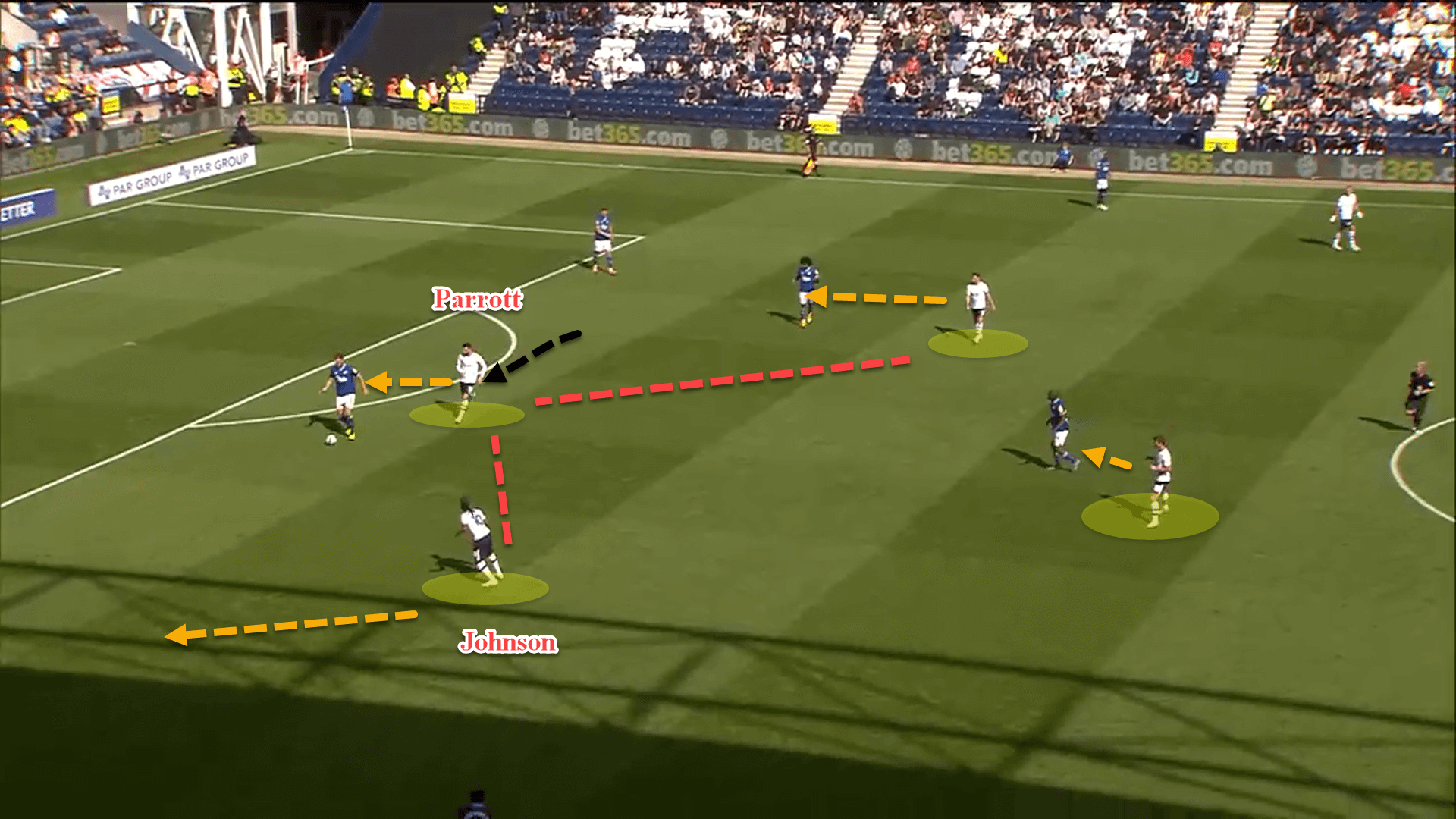
This type of high-block defending requires a lot of coordination and practice on the training ground and, by the looks of it, Lowe has drilled his stars immensely in this phase. The players must know when to get tighter to an opponent, when to hold their position, when to apply a cover shadow while pressing and, finally, when to actually close down.
The image above is a superb representation of Preston’s high block principles working wonders. Center-forward Troy Parrott is applying pressure to Watford’s central defender, angling his run to block off the passing lanes behind him.
Meanwhile, right-winger Alan Browne and Preston’s nearest central midfielder are man-marking the Hornets’ double-pivot, again, cutting off these options.
Finally, left-winger, Daniel Johnson, has held his position in the middle. If he goes too early, a passing lane will open up through the middle. Johnson waits and waits, and as soon as the pass is played, he steps out to close down Watford’s right centre-back, angling his pressure to prevent him from coming back inside.
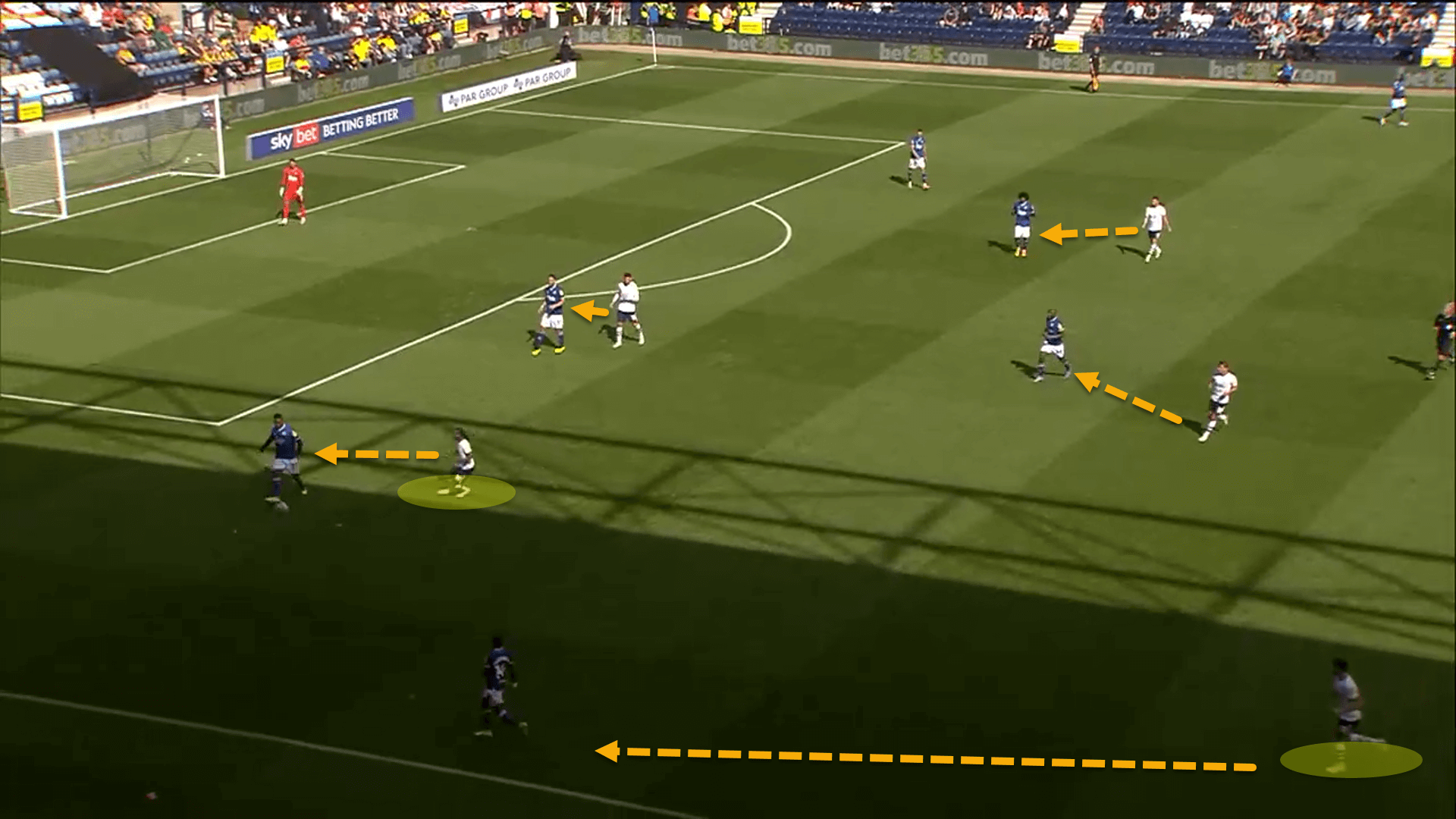
In Preston’s 3-4-2-1, the front three are deployed as the first line of pressure when pushing high up the pitch. They remain narrow together, cutting off access to the opponent’s deepest midfielders.
Nevertheless, there are times during a game where this first defensive line is broken with a split pass and so there must be a backup plan. In these scenarios, the nearest midfielder for Preston quickly steps up and aggressively closes down the ball receiver.
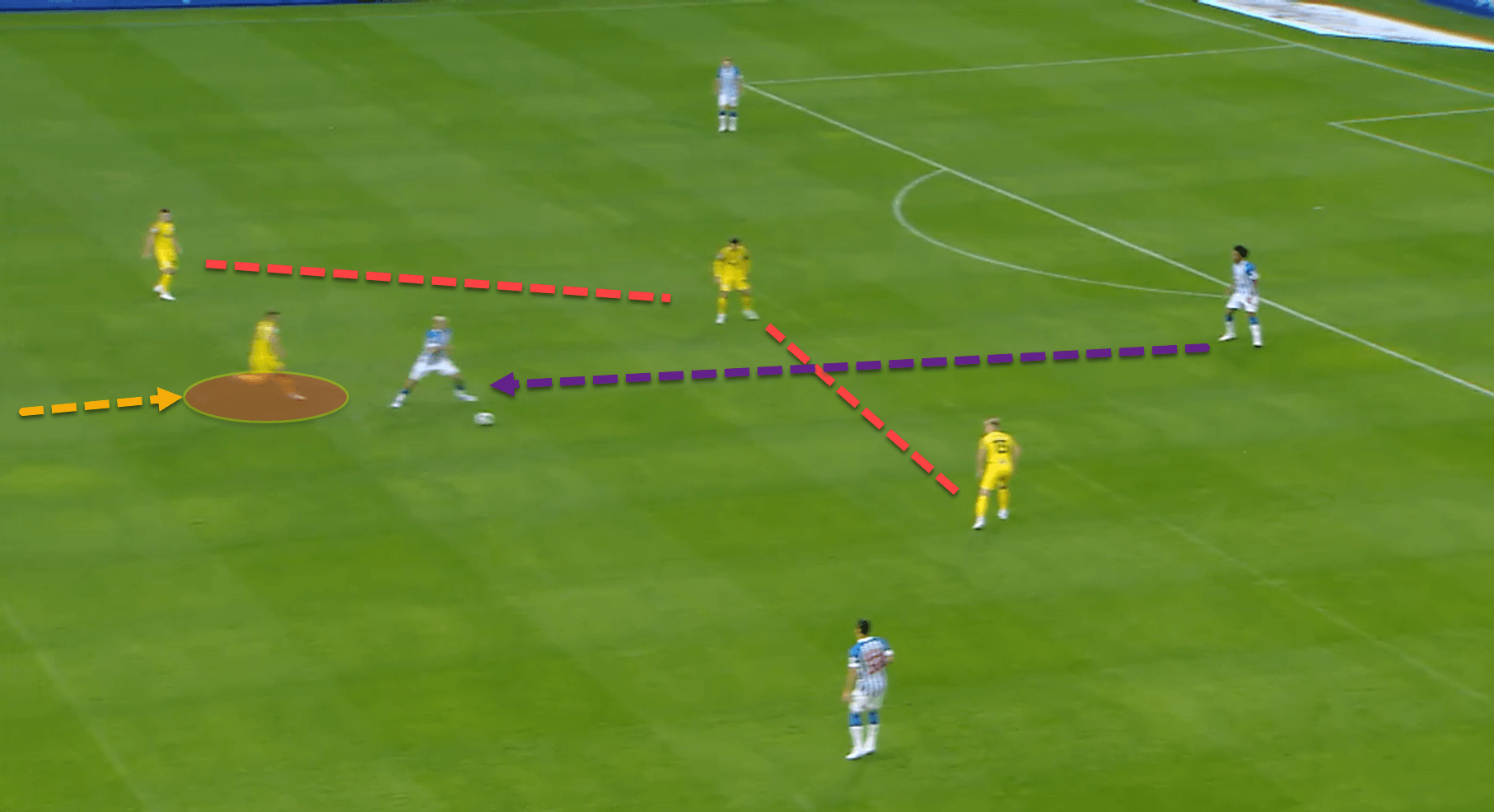
While Preston may not press too high in the final third, overall, their pressing statistics all over the pitch are impressive. The Lilywhites are boasting a lowly Passes allowed Per Defensive Action of 8.34 which is the fourth-lowest in the division.
Moreover, Lowe’s side are really aggressive in their challenges. The best metric to measure this is through challenge intensity which looks at how many defensive actions are made by a team per minute of opposition possession. Preston hold the joint-fourth highest in the Championship with 7.
England’s second division is such a tactically diverse league and so Preston also need to be able to defend long balls when opponents opt to pump it long from the build-up phase rather than try to play through the press.
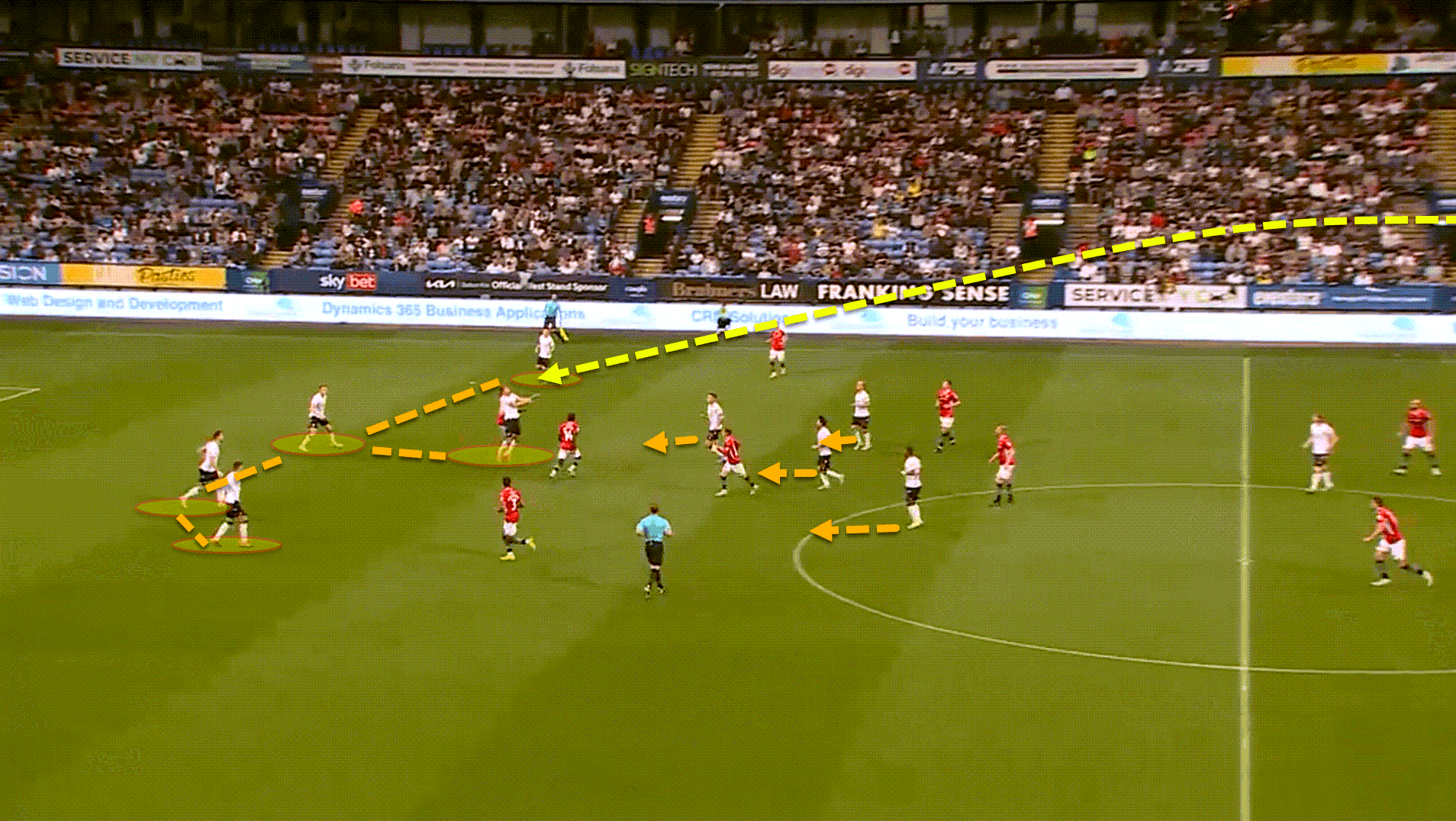
Challenging in the air is an area where Preston excel. One of the reasons for this is because their centre-backs are very dominant.
As shown from the previous image, when the ball is kicked directly to the opposition’s strikers, one of the central defenders steps out to contest the aerial ball while the remaining four defenders drop off and close together to set themselves in case the ball is flicked on to a runner in behind.
This was touched on in an analysis on the Total Football Analysis website last week when we looked at why Bolton Wanderers have significantly improved under Ian Evatt. Again, the centre-back steps out to challenge while the other four defenders drop off and compact.
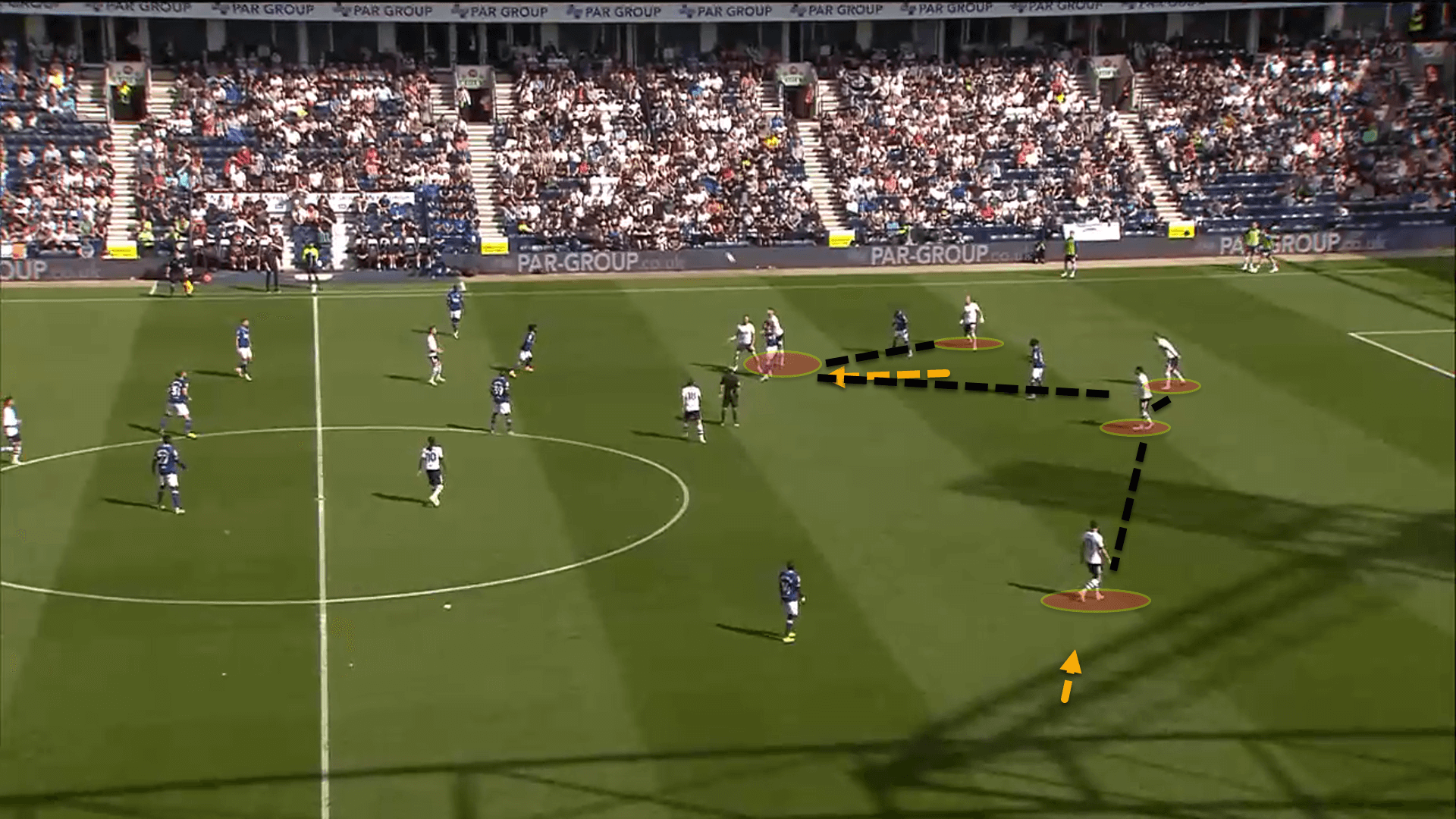
Preston have competed in 51.43 aerial duels per game this season in all competitions on average, winning 53.3 percent. Against them, their opponents have won just 38.3 percent on average, proving how truly dominant Lowe’s side are during these situations.
Deeper defending
As with all great defensive sides, Preston are extremely difficult to crack open when the players have consolidated into a compact shape further down the pitch in the mid-to-low block phase.
Like their principles when pressing high, the Lilywhites’ tactics don’t change too much, but the side are far more aggressive lower down the field as they look to regain possession.
When the opponent has possession of the ball in the central corridors, the first line of pressure, once again, stay close to one another. The objective, as ever, is to prevent the centre-backs from being able to reach the pivot players.

This causes one of two things to occur. The defenders will look to play long, directly to the centre-forwards in order to progress play, or they will go wide and attempt to attack down the flanks.
This plays into Preston’s hands because, as covered in the previous section, Lowe’s centre-backs are really efficient in winning their aerial duels and because the mid-table Championship outfit want to entice the opposition to play down the sides as they can aggressively close down the ball.
When the ball is in the central areas, Preston’s structure remains as a 5-2-3 but once the play is moved to the wide areas, the wingers push wider and drop off, forming a 5-4-1 shape.
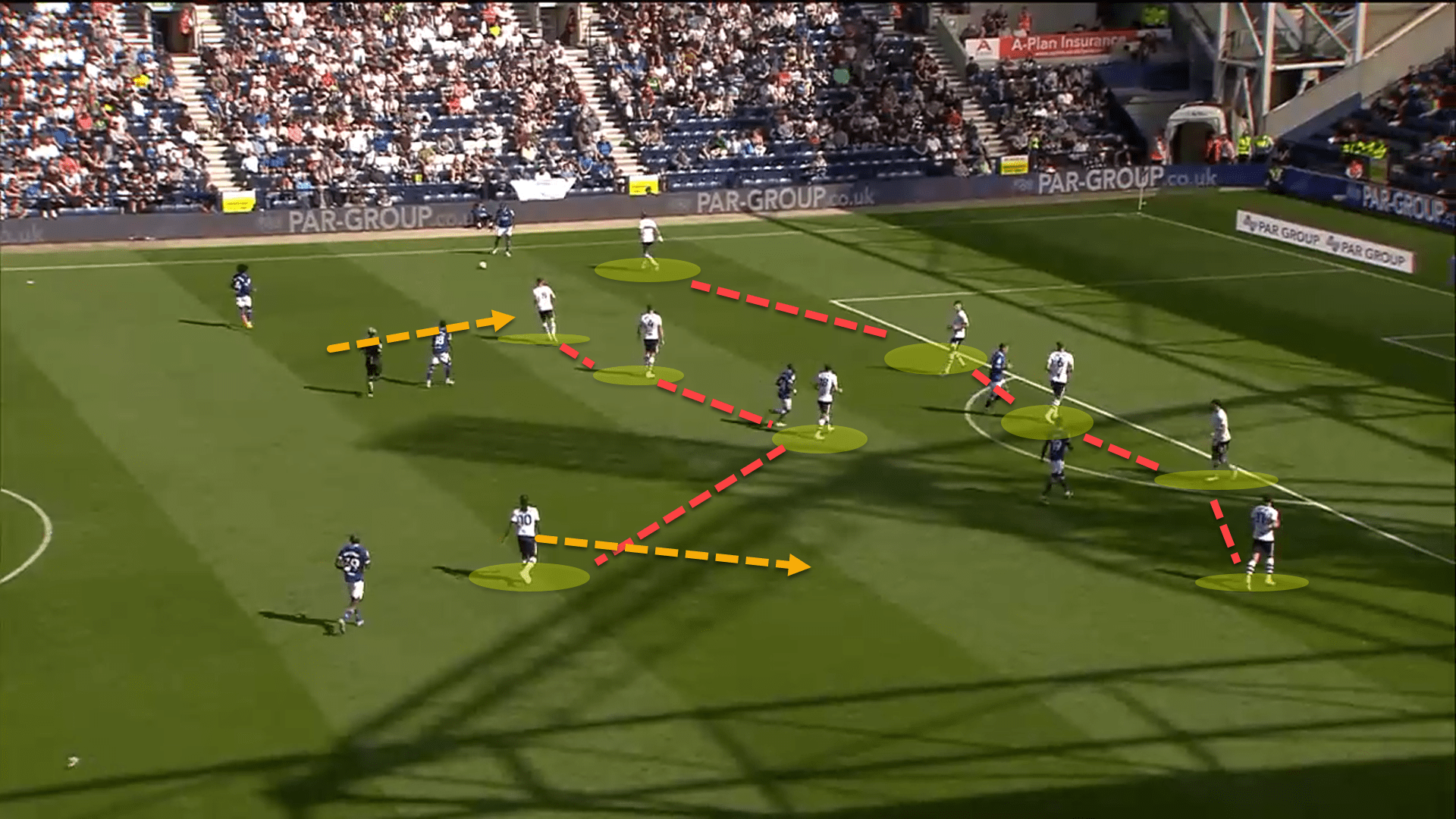
The 5-4-1 is the perfect formation to defend the wide spaces of the pitch. The nearest winger, midfielder, wide centre-back and wingback can all move closer together and close inside passing lanes.
From there, Preston use the touchline as an extra man, limiting the directions that the ball carrier has to play in.
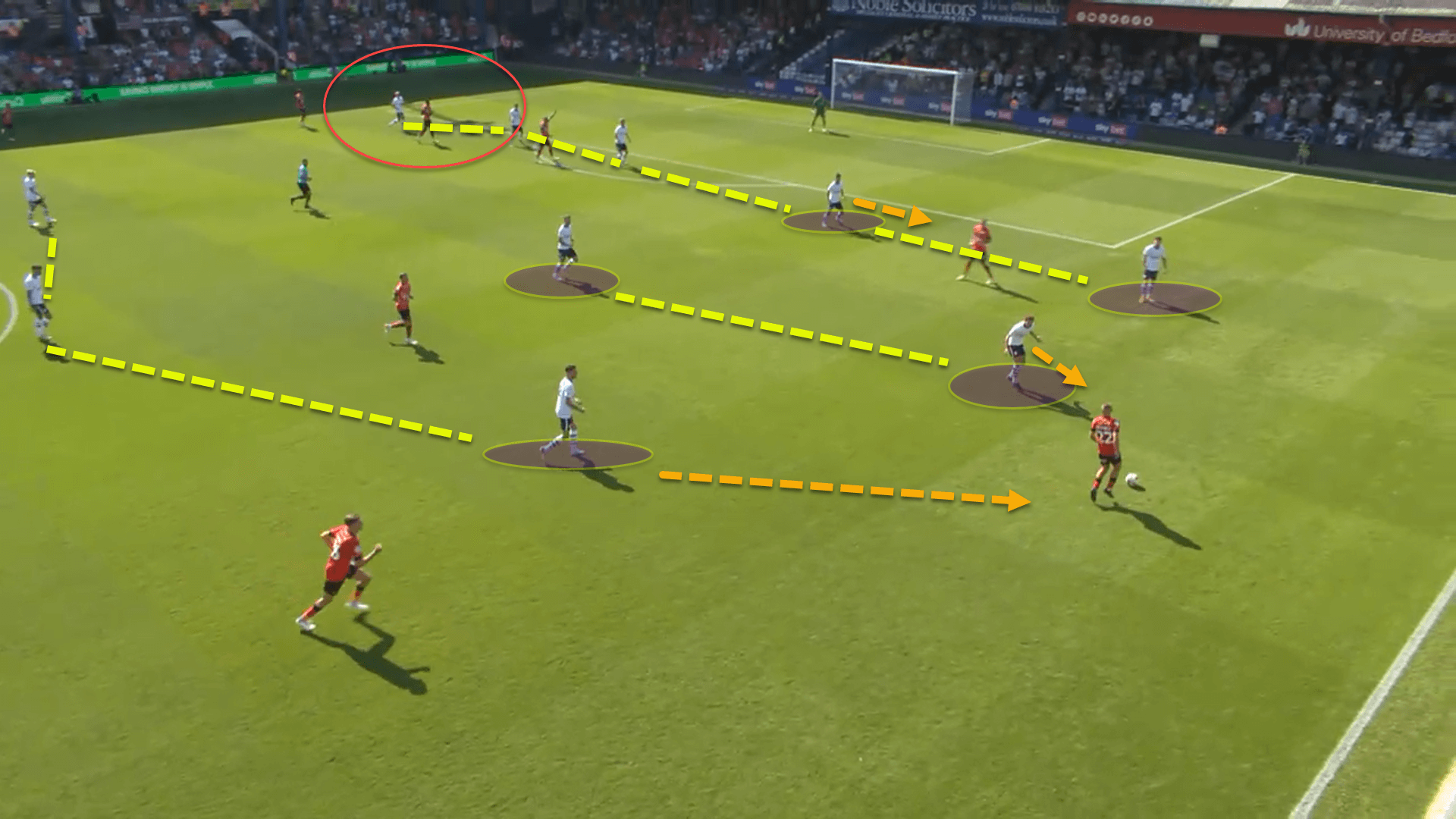
This can be seen from the above example. The left-winger is quickly tracking back as Luton Town have progressed the ball down the flanks into the final third. The nearest player in the double-pivot has shuttled across while the left centre-back and left wingback are also stepping over, creating a defensive overload.
Furthermore, another wonderful benefit of such a wide defensive formation for Preston is that the players can cover most of the width of the pitch, including the back-post which can normally be exploited by crosses or switches of play when a side shifts their defensive block across to one side.
In these defensive overloads out on the wings, Preston’s objective is to aggressively close down and win back the ball with numerical superiority. This was evident from the team’s defensive duels map against Luton in the side’s only victory of the league campaign thus far:
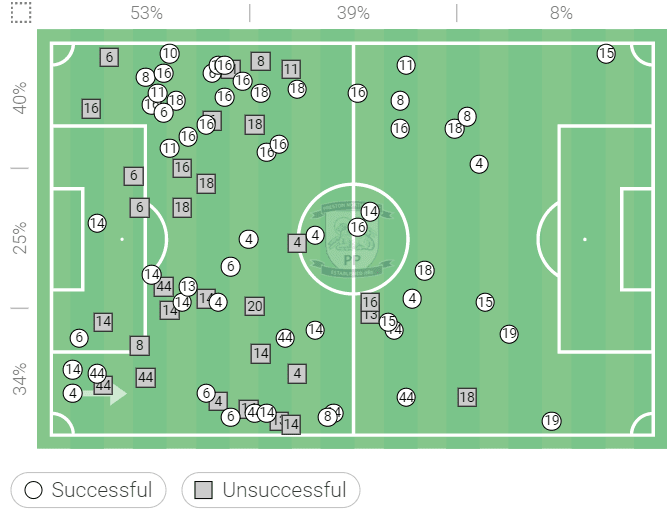
Of their 88 defensive duels, Preston won 64.77 percent. 74 percent were in the wide areas including the halfspaces, while 53 percent occurred in the defensive third of the pitch.
Lowe’s defensive tactics have worked wonders so far as opponents have found it incredibly difficult to break down the Lilywhites, especially when sitting in a deeper defensive block.
Sustainability and its impediment on Preston’s attacking
Unfortunately, while Preston’s defensive displays have been admirable, the data points towards this being unsustainable. Having not conceded a single goal this season in the league, the team’s xG against stands at 6.23 which is the ninth-highest in the division.
Furthermore, Preston are conceding an xG of 0.118 per shot on average, the eighth-highest in the Championship. The biggest issue for Lowe right now is that his side have scored just once. Although it was a truly glorious strike from Brad Potts against Luton, should Preston begin conceding goals, the team could be in for a slippery slide down the table.
However, are Lowe’s defensive tactics hindering the team’s ability to create chances? Simply put, not really, but there have been certain issues evident, particularly when Preston are defending in a low block for large parts of the game.

The biggest issue with low block defending for such lengthy periods of time is that rest defence structures have become so commonplace and secure in the modern game. Once teams finally win the ball lower down the pitch, most opponents will quickly counterpress them, which makes it highly difficult to play out of the pressure.
Furthermore, as Preston win the ball back a lot on the flanks, this means that it’s even tougher to break through the opposition’s pressure as there is little space to manoeuvre given the players are so close to the sideline.
As portrayed in the previous image, Preston regain possession in a low block state, but Luton’s aggressive counterpress forces their counterattack to break down almost instantly.
The Lilywhites are averaging 1.57 counterattacks per game in this campaign in all competitions, but just 27.4 percent end in a shot on goal. Moreover, not a single counterattacking goal has been scored thus far.
Conclusion
Preston’s defensive tactics aren’t the primary cause of their lack of goalscoring, just a symptom of it. While the counterattacks aren’t really working, the lack of quality and end product in the final third are the main reasons why the goals have dried up.
Preston’s wonderful defensive record is the only reason why Lowe’s side are not way down near the end of the table.
Something has to give. The goals need to start coming as the wall will begin to let water through eventually which could cause a devastating flood for the Deepdale club.






Comments